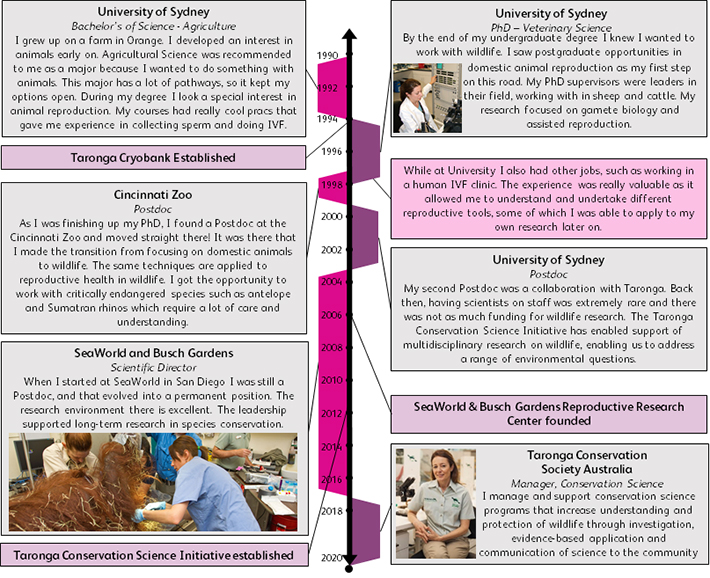Ever wondered what it takes to become the Manager of Conservation Science at Taronga? We sit down with Dr. Justine O’Brien to hear about her journey from university student to reproductive physiologist to scientific director - and everything in between! Find out what it is like to work in the field of animal reproduction and how her research in reproductive science is playing a key role in species conservation.

Ask me anything
What kind of information can you gather from collecting sperm and eggs? How does this relate to wildlife conservation?
Information on the functional capacity of eggs and sperm can be built into a database, allowing us to monitor the long-term reproductive health of a species. When we collect and analyse samples from healthy, thriving populations we can use these data as a baseline for the future and identify abnormalities as they appear. It also allows us to use samples for potentially producing offspring.
What has been the most challenging species to work with?
Polar bears - they are so unique and cryptic! Species that exhibit embryonic diapause (when an embryo goes into dormancy soon after fertilisation and prior to implantation) are so interesting and tricky to understand. Each species that exhibits this trait appears to have different factors that cause the embryo to activate, and we still do not know what that is for the polar bear! There are others like macropods, whose sperm are really hard to freeze - we have not cracked that one yet. The Tassie Devil for example, still needs a lot of work. At the moment our success for cryobanking (ultra-low temperature storage of biological samples) their sperm is very low, with only 3-5% of cells showing motility after thawing, and we’d want at least 40% to really say that we have been successful.
What are the major ethical considerations related to this kind of research?
For some species like the white rhinoceros, we need to anesthetize an animal to collect sperm samples, so there is always an associated risk with that procedure. We try to collect samples when the individual is already undergoing a health assessment. Talking to animal care staff, vets and training animals to participate in their care is important so that the process is not stressful. We are also constantly creating new methods to monitor health non-invasively, like though faecal sample analysis. Another somewhat controversial idea is offspring sex-ratio biasing to increase population size. We have already intervened so much in nature; if it is a tool to help them survive the instability that we have created, I think we can justify that.
The media went crazy over the world’s first AI penguin. What does this kind of publicity do for public interest in your research and conservation outcomes?
How to clearly communicate the important information is tricky. What we did was a first for penguins. Very few animals have been produced using the technique and low number of sperm (fresh or frozen-thawed) that we used. For penguins, there was a lot unknown about their biology and the importance of food availability prior to the breeding season, before females reach breeding grounds and find their mate. Studying zoo-based populations has helped us to better understand their reproductive processes and the energetic requirements prior to egg lay. For example, female Magellanic penguins take around 4 weeks to produce a fully formed egg. It turns out that the female is growing her egg for approximately three weeks while she is at sea prior to returning to land to breed. So we try to highlight these remarkable processes to the public. The publicity raises the profile of threats that species face in the wild as well as awareness of the importance of long-term monitoring, biobanking and genetic diversity to species conservation.
How do you see conservation science at Taronga changing in coming decades?
The footprint we have in breed for release programs is getting larger and larger, so embedding science in these programs is a big priority. While individuals are in our care, we collect crucial knowledge for supporting them into their future post-release. We are assisting to find answers to key questions that support their survival in the wild, such as what life stage and time of year is best to release. With the rise of genomics, we also have powerful tools for understanding which animals may be best to prioritize for breeding. For fragmented species such as the bilby this is very important. Biobanking will also become more and more important for securing biodiversity, and Taronga’s cryodiversity bank is a valuable part of this. Our role will always be to protect natural habitat, engage the human population to live tolerantly and support our green (and blue!) spaces. We can do this by linking the science to our messages and education initiatives.
What’s the most challenging part of a career in conservation science?
Jumping from grant to grant can be hard as there is not a lot of security, but that is the current reality of getting into research. The path is less difficult if you surround yourself with positive colleagues and mentors. I have gotten to work with excellent teams of experts and have found this to be a great motivation to keep going when you have funding challenges. It is also important to maintain a work-life balance.
What advice would you give to someone who wants to work in conservation science?
Just say yes to as many opportunities as you can. Keep the door open. You may not think it will lead anywhere, but sometimes the little things open into networks you are not familiar with. Find good mentors and take your time to understand what you really enjoy doing as you set out on a research career path.